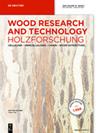Decay resistance of southern pine wood containing varying amounts of resin against Fomitopsis ostreiformis (Berk.) T. Hatt.
IF 1.6
3区 农林科学
Q2 FORESTRY
引用次数: 0
Abstract
Resin production in wood tissues is a regular feature of pine wood species, including southern pine. High resin contents of southern pine wood may increase wood resistance against decay fungi. The current study investigated the effect of resin contents in southern pine wood on decay resistance by exposing non-extracted heartwood, mixed wood (sapwood + heartwood), and sapwood blocks with varying resin content to brown rot,含不同树脂量的南方松木对 Fomitopsis ostreiformis (Berk.) T. Hatt.
木材组织中产生树脂是包括南方松在内的松木物种的一个常规特征。南方松木材中的高树脂含量可能会增强木材对腐朽真菌的抵抗力。本研究通过在实验室腐朽试验中将未提取的心材、混合木材(边材+心材)和不同树脂含量的边材块暴露于褐腐菌 Fomitopsis ostreiformis,研究了南方松木材中树脂含量对抗腐性的影响。在索氏提取器中使用三种溶剂对每种木材类型的匹配木块进行连续提取,以确定树脂含量,并同时将其暴露于腐烂菌中。结果表明,未萃取心材和混合木材的质量损失取决于树脂含量水平,在树脂含量超过 31% 的木块中观察到的质量损失非常小或没有。边材的质量损失较高,但树脂萃取物的存在显著提高了抗腐烂性。所有溶剂萃取木块的质量损失都很高(53-55%)。扫描电子显微镜显示,褐腐菌丝的穿透和细胞损伤取决于木块的树脂含量。通过气相色谱-质谱(GC-MS)鉴定出的大部分化合物属于油脂类,其中单萜烃、含氧单萜和倍半萜在心材中的含量高于边材。
本文章由计算机程序翻译,如有差异,请以英文原文为准。
求助全文
约1分钟内获得全文
求助全文
来源期刊

Holzforschung
工程技术-材料科学:纸与木材
CiteScore
4.60
自引率
4.20%
发文量
83
审稿时长
3.3 months
期刊介绍:
Holzforschung is an international scholarly journal that publishes cutting-edge research on the biology, chemistry, physics and technology of wood and wood components. High quality papers about biotechnology and tree genetics are also welcome. Rated year after year as one of the top scientific journals in the category of Pulp and Paper (ISI Journal Citation Index), Holzforschung represents innovative, high quality basic and applied research. The German title reflects the journal''s origins in a long scientific tradition, but all articles are published in English to stimulate and promote cooperation between experts all over the world. Ahead-of-print publishing ensures fastest possible knowledge transfer.
 求助内容:
求助内容: 应助结果提醒方式:
应助结果提醒方式:


